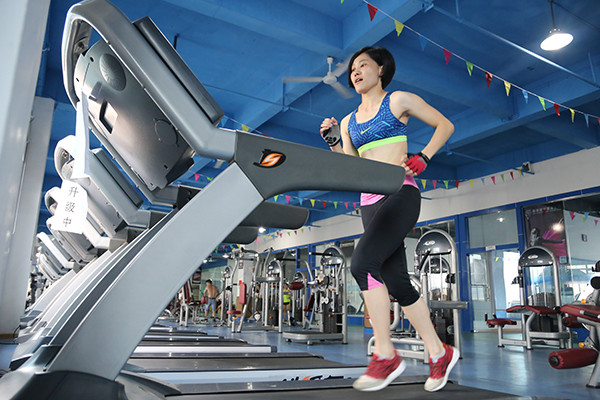
A women runs on a treadmill in Chenzhou, Hunan province. Going to gyms is now a popular workout option for the working class even beyond first-tier cities. (Photo/China Daily)
Fitness industry innovates and expands as more and more Chinese exercise to stay healthy, creating huge potential for growth
The fitness industry in China is booming on the back of a keep-fit fever that is sweeping the urban white-collar population.
A report by the Qianzhan Industry Research Institute, based in Shenzhen, Guangdong province, showed that sales at China's fitness industry have increased to 127.2 billion yuan ($19.6 billion) in 2014 from 69.1 billion yuan in 2009-that is, a whopping 84 percent rise over a five-year period or an average annual growth rate of almost 17 percent.
The number of gyms or fitness clubs, too, has risen to a record 3,650 in 2014 from 2,930 in 2009, at an average annual growth rate of 5 percent. Figures for 2015 are yet to be released, but are presumed to reflect the uptrend.
On average, there is a gym for every 1 million people in China, far behind the United States, where there is one for every 10,000 people. There is just one fitness instructor for every 83,333 Chinese.
According to a survey by Nielsen Holdings Plc and the General Administration of Sport of China, there are 3.5 million gym members in China compared with 50 million members in the US.
This means, the potential for growth in China is huge. This is confirmed by the fact that the number of people who often take exercise has risen to 382 million in 2014 from 373 million in 2009.
That rise is attributable in part to the wide range of fitness equipment and professional services (like those of fitness instructors and dieticians) that gyms offer these days and in part to general health awareness.
The variety in fitness regimens is also an attraction. These days, gym customers could do aerobics, practise yoga, dance, use fitness equipment and swim.
The Nielsen-GASC survey said fitness-minded people take exercise 7.5 times per month, and spend 10,000 yuan per year on average to stay fit and healthy.
That explains the rapid rise of fitness applications, which 75 percent of gym members use while exercising.
Yet, just around 20 percent of gyms in China earn a profit. About 50 percent of gyms, which offer just a few value-added services, are facing tough conditions due to a limited number of customers, according to industry insiders.
Competition among gyms in first-tier cities like Beijing, Shanghai and Shenzhen is fierce. At some places, price wars are under way. Well-known gym chains are expanding into the third- and fourth-tier cities.
Industry experts said going forward, gym operators, in order to survive the coming price wars and thrive, should change their current business model to include not only exercise classes but personal trainers, health lessons, diet guidance, outdoor activities and other high value-added services.
Jung Da-yeon, a South Korean diet writer and fitness guru, is considered a good example of how to innovate in the fitness industry. She launched early this month her fitness brand Zetness in China, aiming to build up an exercise community and a diversified fitness system.
The brand covers a fitness app called SLine, a trainer institute and a Zetness fitness club. The app could connect fitness clubs and customers, who could communicate on the online platform, make reservations, learn about instructors, track their fitness results, make online payments and obtain diet guidance.
Zetness aims to integrate online and offline resources, and optimize users' fitness and social experiences and explore different derivatives such as Jung's clothes, nutritious meal, and teaching materials.


















































